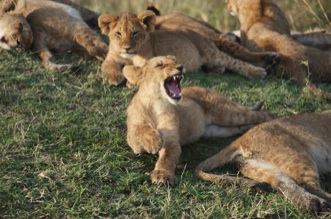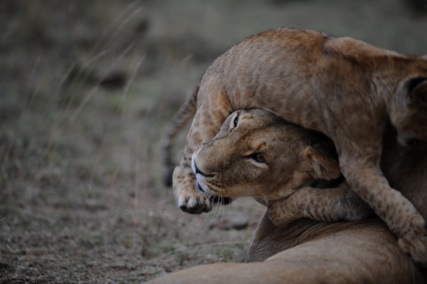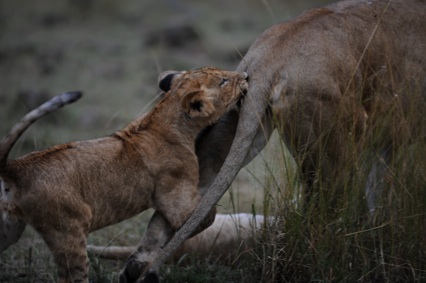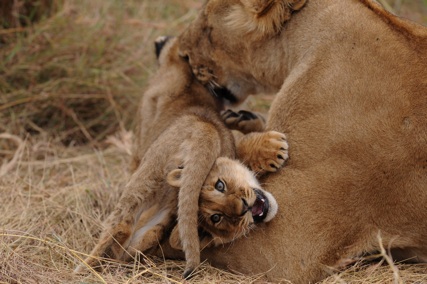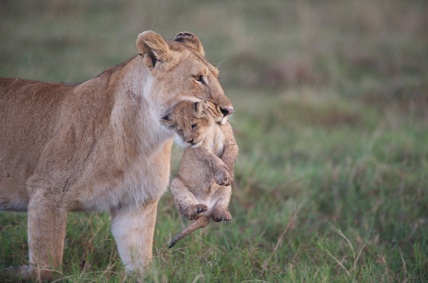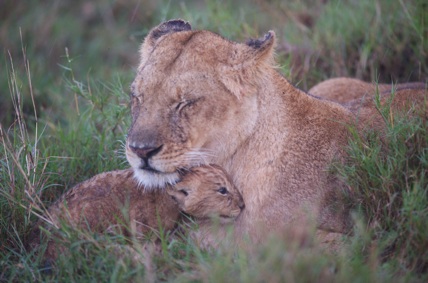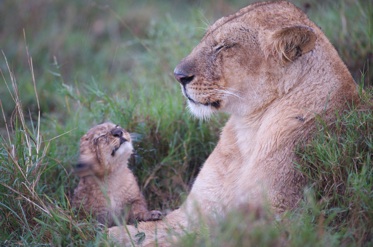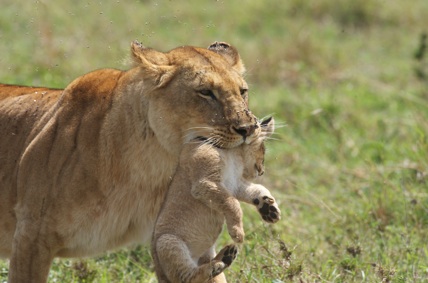
Notes from the Field
Night Crossing
Dateline: Mara River October
We had been sitting on top of the car for hours, playing cribbage, talking East Africa politics and conservations issues, drinking water by the gallons and watching other vehicles, and the world, go by. Nothing else was happening so what the heck……
In theory, the wildebeest should have been crossing the Mara River right about this time, and there were thousands and thousands of the animals in the area; but none seem particularly motivated to get the show on the road. The herds would consistently, and half-heartedly, ease towards the water, stopping a few hundred yards from the embankment, and its assortment of crocodiles, only to turn and, heads low, stride heavy and slow, turn and ponderously head back to the safety of the way they had come. The wildebeest even followed the same very narrow trails that had brought them down to the river only minutes before.
Most of the river crossings that I have witnessed over the past thirty-odd years take place in mid to late morning, almost always finishing up by lunch time; very considerate of the animals. Perhaps the heat gets too much and the masses lack the required enthusiasm to cross, or perhaps it takes them hours from where they had spent the previous night, well away from the river and its dangers, to reach the Mara River that next morning.
I’ve been jotting down the crossing times, the numbers, and any “special notes”, of the wildebeest for decades; and a pattern definitely emerges.
- Crossings mostly (but not entirely) take place between mid-morning and early afternoon.
- If zebras are also present, let them start the crossing.
- Perhaps the very first few wildebeest quietly walk into the water, but after that its just “Hell bent for leather”, and the wildebeest charge in, huge splashes, everyone for himself.
- Herds do not wait around for individual animals, even young, that get separated during the crossings.
- After crossing, the herds usually run a hundred yards or so away from the river and then go right back to their head-low plodding.
- Young wildebeest get killed by crocs more often then adults simply because they get swept downstream more often and end up isolated below the swimming chaos of the main herds.
- Crocs almost always attack from down stream if there is any significant current.
We had lunch with us, a really fancy lunch; and as the early afternoon wore on we proceeded to spread out our fairly sizable feast on the open roof hatches of my landcruiser.
We watched vehicles come and go, leaving trails of dust behind them as they retreated. WE watched wildebeest and zebra families come and go, leaving trails of dust behind them as they retreated. My patient group elected to just wait it out as we had already seen such an incredible amount of wildlife and predatory action in the last twelve days that we were under no pressure to chase after something else.
5:00pm approached and fewer land rovers and land cruisers ventured as far as the river. One land rover, however, did pull right up beside us, a vehicle that contained four game rangers. They commented that we had been there most of the day, we agreed and talked about poaching, tourism and park issues, and shared our tea with the men.
I, kind of out of the blue, asked the ranger in charge if we could stay a bit later than normal, and if we could be allowed to go back to camp after dark. I explained where we were staying, they discussed it briefly, made one radio call, and then told us, much to my surprise, that it would be no problem to remain at the river until dark. But if we got lost going “home” it would be our fault, and that we shouldn’t call them, regardless. Amazing; I very quickly, and very happily agreed, and fifteen minutes later their poor old land rover rattled off, fading over the hill as the sun faded westwards, sinking somewhere over Lake Victoria, and then the Atlantic Ocean.
The sun rises and sets very quickly near the equator, where the world is spinning at its fastest and where the sun drops and rises at its most acute angle. As 6:30pm approached the air began to cool dramatically and the darkness no longer crept up on us but gathered raced to envelop us.
We and the wildebeest also seemed to get invigorated by the cool darkness and within twenty minutes tens of thousands of wildebeest were pressing on the shoreline. I couldn’t believe it; Do they actually cross at night, and we never believe it simply because we never see it?
Suddenly the masses of black bodies that had completely surrounded our vehicle all began to run, then stampede in panic; and a lioness trotted up from behind, us, stopping right at the bumper of our vehicle. But she had been “busted”, spotted by the wildebeest and zebras, and seemingly content, flopped down by our vehicle and joined us watching the movements of the migrating masses.
With almost no prelude or warning, wildebeest were suddenly at the rocky shoreline, rapidly picking their way through the boulders and down to the water itself. With no pause at all they waded in, unable to leap into the current from the broken shoreline. The zebras pulled back and moved rapidly away, disappearing from our site in the ever-rising massive cloud of dust set heavenwards by the thousands of racing wildebeest hooves.
The moon, at over 2/3rds full, was up and shining on the chaos in front of us. It shown with enough strength that we could not only easily see but could even take photographs of this unique crossing.
The hippos, which had been congregated in a large pool just downstream of the rapids, became increasing nervous and more and more wildebeest were swept down and into their calm retreat. Eventually the entire crossing masses of wildebeest were all pushed into the hippos as those wildebeest on shore starting entering the river farther and farther downstream as they followed those wildebeest that were grabbed by the current.
The hippos had not choice but to give up their pool and vacate for the very place the wildebeest were coming from; the dry plains that bordered the river. In all some fifteen hippos, in near panic, relented and crashed for the shoreline, throwing out huge bow waves of white that shown in the moonlight as they escaped the driven herds entering the river.
We saw wildebeest actually bashing into hippos, hippos biting them or head-butting them away as they fled towards the dry ground themselves. On and on it went, twenty minutes, thirty minutes, forty minutes, and only then did the numbers of wildebeest driving in start to lessen. We were all breathless from it all, in total awe of it all, and I was astounded that we didn’t see a single croc make even a single kill. Certainly dozens of dead wildebeest were floating in the hippo pool and were trapped in the rocks, or beaching on the shoreline. Surely they would be eaten as well; but still, not a croc kill was witnessed.
Exhausted, dusty, cooked by the sun, we happily fired up the engine and slowly turned towards home; chattering a million miles an hour about what we had just seen, reliving the experiences again and again.
For decades hyenas were thought to be purely scavengers, based largely on the fact that most observations of hyenas were done at dawn, and not at night. We now know, of course, that most lion, leopard and hyena activity takes place during the dark hours. Perhaps more of a wildebeest’s activities also takes place at night. We’ll see.
Bloody Amazing!
Dateline: Maasai Mara Reserve
Time: 6:00am, August
Its always cold in the mornings in the forest along the Mara River, regardless of the time of year. The male leopard across the river had woken me at 3:00am with his growling territorial call and Iʼd be dozing off and on since. The lions to the northeast had also sounded off, but just before dawn; and they were quickly answered be three hyenas, probably not at all happy about being made aware of the lionʼs presence.
Wanjao had brought me my hot coffee pot, to my open tent, just before 5:30am and heʼd assured me that everyoneʼs coffee was on the way. I rousted, pulled on my shorts, shirt, fleece and jacket, and was sitting on my tent verandah three minutes later; listening to the “dawn chorus” of all the song birds, with the occasional predatorʼs voice still punctuating the background.
I met the askaris at the fire twenty minutes later and a few minutes after that all my guests began to slowly filter in, couple by couple, tent by tent. With little talk we quietly bundled into the two vehicles and wound our way out the forest track, heading for the open plains a few hundred yards away.
We popped out of the forest onto the grassland and hadnʼt gone two hundred yards when two young wildebeest came “fast-canteriing” past the bows of our two vehicles. When they were just meters in front of us I suddenly realized it was not two wildebeest but one yearling wildebeest with an adult hyena right on its tail, and matching it stride for stride.
I dropped down from the roof and instantly alerted Koskei, and he, in turn, instantly swung the vehicle into pursuit at a a discreet distance. I had him radio the other vehicle and the “hunt” was on.
The speed of the two animals, both predator and prey, was amazingly fast, though it didnʼt seem so at first. But we, in our landrovers, were having a time of it, trying to keep up with the fast-loping animals. They cantered in and out of gullies, across small ditches, over termite mounds, and in and out of the forest edge; never slowing, eating up the ground at quite a rate.
Fully three kilometers on the young wildebeest made the drastic mistake of turning to face its pursuer. Perhaps the yearling was tiring and going into oxygen debt, perhaps he thought he could face down the hyena, but either way, it was a huge, huge mistake.
Without even breaking stride the hyena dove in, ignoring the spike horns of the yearling, and grabbed the panting wildebeest by a back leg, tearing it open with one violent slash of its jaws. The wildebeest bawled and spun to face its attacker. But already I knew it would just be a matter of time now, not a matter of if the wildebeest would die; but when it would die. Killing takes patience and no predator exhibits more patience than a hyena.
The stand-off begins: The hyena rests a bit and then starts a casual run in at the wildebeest, not a death threatening attack, but just runs in near enough to force the yearling to defend itself, run at the hyena, exert energy and bleed more. The hyena casually dodges out of the way, canters ten yards distance, pauses, and runs back in again; eliciting the same response from the panting prey. Again, again, and still again, these charging runs make the wildebeest defend itself. The tireless hyena never ceases, only pauses between each rushing attack.
Suddenly, for no apparent reason, the wildebeest falters, wobbles, and actually drunkenly stumbles and falls. The toll of the initial chase, of the blood loss, of the defensive actions, become obvious. Almost the instant the wildebeest hits the ground the hyena is on it, tearing at its flank with easy success. A sizable chunk of flesh tears away and the bleeding increases dramatically.
To everyoneʼs horror and surprise the wildebeest struggles back to its feet, even as the hyena rips more flesh from its bleeding lower abdomen. The wildebeest bawls, falls and sits there while the hyena eats the bolus of flesh. The predator returns and grips the wildebeest again, and with yanks at its body with such violence that the entire young wildebeest is twisted and tossed sideways as it lies on the ground.
Out of nowhere a second, a third, and finally a fourth and fifth hyena appear. But all of them save one keep back, evaluating what is going on and who is doing the killing.
A hyena clan is a highly organized, highly structured and complex social society. The female that has the wildebeest is certainly a dominant female as all the smaller (probably male) hyenas remain at a respectful and safe distance of fifteen meters or more.
Yes another hyena, a large, now meanders between the trees and winds its way casually towards the fighting, and dying wildebeest. Its a female I think; based on her size and the relaxed and confident way in which it is approaching the action. She doesnʼt stop or raise up her head to investigate. Sheʼs obviously heard all the commotion from some distance, and maybe watched the original chase across the open plains. She knows both what is going on and what she is about. Certainly some of the kill will be herʼs, no argument.
True enough! The recent arrival walks, just walks up to the other hyena, that is now gripping the wildebeest by its hip, and settles in beside it, and then pushes forward, in no hurry at all, and with fearsome power, tears out a massive chunk of flesh. Intestines spill out as the wildebeest drops to the ground. With that collapse the two predators come closer and start feeding on the entrails (eat the high nutrition parts first as you never know if youʼre going to lose the kill to lions). The wildebeest goes flat over on its side as the two violently tear into its stomach and chest cavity.
To our horror, the wildebeest yearling raises up just in time to watch the larger of the two hyenas tear out and eat its liver, before lowering its head to the grass for the last time. And finally, more than forty minutes after it started, it ends. Only the two females feed on the flesh; never allowing the others, that have gathered, to even approach the carcass.
Six hyenas and my group wind back through the trees and out onto the open plains; we head south towards the river while the hyenas head straight east, towards their den on Rhino Ridge.
(on our way back to camp at lunch time we stopped by to check on the remains of the kill. Nothing, not a scrap of fur, bone or hair, was there. Even the hooves had been taken. Only a dark spot on the grass indicated that anything at all had occurred.)
Maasai Mara Reserve, March 19th, 2011, mid-afternoon.
Rain approaching from the east-northeast.
We had driven out of our tent camp after tea (and cake) and were angling northeast across the top end of Paradise Plains when I saw the distinctive long yellow-gold waving stiffly in the wind. The rains hadn’t come yet and the wildebeest were long gone now. Nothing but a lion’s mane would be long enough to wave in the wind, the grasses having either been eaten or trampled by the immense herds of wildebeest that had passed through these plains months earlier.
From my position on the roof of my land-rover I called down to Koskei, telling him to swing left, and let him know that we had lions about half a mile in front of us. I dropped down from my perch, told the guests what to expect in the next few minutes, and started preparing my own camera gear. I pulled off the 28mm-200mm zoom, and opted for a straight 300mm, F2.8 fluorite lens instead. The light would be fading fast and I’d need all the speed I could get. I bumped my ASA to 400 and poked my head back up through the roof hatch to help Koskei with our approach to the lion pride.
This pride we were quite familiar with, having spent four to eight days a month with them since the previous June. We’d watch the growing bellies of the lionesses as their synchronized pregnancies progressed, were there shortly after the kittens were born, and had repeatedly had the joy of watching the little ones tussle and play their way towards adolescence. But even now they were still only three and a half months old, months short of being able to accompany their mothers along on hunts. At this age the cubs were really nothing but trouble, and spent their days either playing, sleeping or eating (either meat or milk now).
With approached the pride slowly, circling around to the east side of the group to keep the sun behind us. Koskei, without being asked, parked a close but respectful distance from the lions, careful to keep our shadow off of them, and careful so as not to disturb them either.
We arrived among the lions a bit early, around 4:45pm, and they were still pretty much asleep; though occasionally a cub would roll over, paw or chew on another cub, and then laze back to dozing. I told my guests they’d be waking up soon, and suggested that we wait for that as the cubs would provide no end of entertainment as they roused from their day’s sleep. The family with me was quite willing to sit it out, and we settled down to a discussion about lion life and pride structure.
I used the time to teach my guests how to identify individual lions by both whisker patterns and their torn ears (the lions torn ears, not my guest’s!). I had my group draw out a few whisker patterns to make sure they understood the system, and we settled back and watched the cubs gradually wake to the world.
Within thirty minutes or so the “show” was in full swing and we were laughing, pointing out this cub or that one as they got more and more active, eventually attacking pretty much everything; everything, whether it moved or not.
The poor mothers, no end of patience, just lay there, sometimes nursing a cub, any cub (lionesses communally nurse and seldom discriminate between cubs that are their own offspring and cubs that are not when the little ones are nursing,). The lionesses, huge compared to the cubs, endured attack after attack from the little golden fur balls, sometimes rather suddenly pinning down some cub and subjecting it to a full bath, in spite of that cub’s vocal protests and squirming efforts to escape.
The light softened into photographic perfection and we were all so busy shooting and laughing that we didn’t really notice the darkening clouds to the northeast. I did notice, however, that one lioness didn’t really partake much in any of the rambunctious behavior.
Suddenly the sky darkened ominously, the temperature must have dropped an easy ten degrees in just minutes, and the clouds were upon us. Even the cubs crowded closer to their mothers, perhaps for warmth, perhaps to quell their worries as the lightening started to split the sky and the thunder began to bounce off the Iseria escarpment.
The lioness that had that hadn’t participated in the rough-housing rose quietly to her feet and almost slipped away unnoticed, heading south across the open grassland, with patient determination.
She walked with such purpose, even in the first few hundred feet, that I strongly suggested that we leave and discreetly follow her. My guests, most understandably, were not keen to leave the pride but reluctantly agreed, and Koskei, who had been listening in, was more than ready to go. Both Koskei and I just “felt” that something was going on and that we just didn’t know what it was yet.
As the big female headed southeast we flanked her, staying at least five hundred yards to the northeast of her, hoping she would not notice, or at least mind, our presence. She didn’t give a second look and plodded, with that loose-foot stride that all lions walk with.
Fifteen minutes later, just as the rain line overtook us and her simultaneously, she reached a deep gully, perhaps twenty feet across and ten feet deep. Without hesitation she slid over the lip of the drop and was gone from our sight, as of she had never been there at all.
Just as we drove up to where we had last seen her she reemerged, on our side of the “lugga” still, but this time with what we thought was a small kill, or piece of a kill, in her maw. The lioness, with the same purposeful stride, now headed straight north out onto the treeless plains and as we caught up with her we could, to our great joy, see that she was not carrying a kill, but very much the opposite. She had a small lion cub clamped carefully between her killer teeth. The cub hung motionless, as they always do, and, head high, the female walked on, the cub swinging like a furry pendulum cradled in her huge mouth. The rain stopped briefly as we scrambled for cameras and lenses. A few shots were managed and then the rain started in earnest.
“Mom” carefully lowered her cub to the ground, sat down herself, and the wee one immediately pushed his way under mother’s rain-sheltering chin and the two of them waited out the storm.
The light went flat on us, and the African night, hastened by the dark rains, so overran us, leaving us with no choice but to seek shelter ourselves. But we vowed to be out before first light to try and relocate mother and son.
The dawn broke clear, Venus high up to the east, with Orion almost overhead, the Milky Way fading fast but still clearly visible. We sat by the campfire, drank a few cups of coffee each, stuffing cake into our mouths between gulps, and talked about the lions, discussing how unusual it was for a lioness to stay with only a single cub (they often abandon singles, or even kill them; and then come right back into heat; and hopefully will have a larger litter.).
Within minutes, even in the dark twilight of pre-dawn, Koskei had no problem finding our pair. They had moved farther north, which we had counted on, and in no time we were on final approach when the mother rose to her feet, picked up the cub, and started walking back towards us!
The muscled lioness strolled, big-striding, right past my land-rover and returned the little one to the same gully. She stayed there with the wee boy for just over an hour, then pulled herself back up the north edge of the draw and walked the two miles or so back to the resting pride.
This will be my last safari of the season, but I’ll catch up with them in June, and be able to follow the little boy’s growth, education and developing skills all next season; can’t wait!


